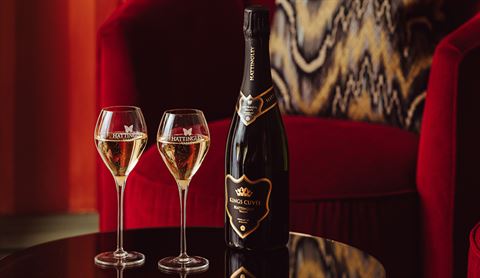November 2024
How to look like a wine pro this Christmas
Welcome to your ultimate Christmas wine guide. Steering you through the reds and the whites of the world is our very own Master of Wine Tim Jackson (who’s got that job on their Christmas list?), who’ll make sure you look like a seasoned sommelier in time for the big day
What wine shall I buy my friends?
Festive fizz is the most obvious gift, but recent price hikes of Champagne have made it a much less affordable option. Instead, why not consider a premium sparkling wine? English sparkling is going from strength to strength at the moment as a British original take on Champagne, minus the hefty price tag. We’re currently working with Hattingley Valley, Digby Fine English, Balfour, Simpsons and Wiston Estate – all delicious and easily found in the UK. Or, if you’re looking for a premium Prosecco and passing through the airport, you’ll often find Bottega – our UK lounge partner – as it has a strong presence at Duty Free.

What wines pair best with my Christmas dinner?
As a general rule of thumb, the ‘meatier’ the dish, the more the flavours tend to favour rich, red wines. And the more intense the flavour of the meat, the better it will stand up to the more powerful reds. As a result, for beef, I’d put a full-bodied Cabernet Sauvignon – especially in the savoury style of Bordeaux – or Malbec high on the list. For lighter turkey or goose, particularly with all the trimmings, I’d still stick with reds, but in a lighter style. Here Pinot Noir wines or Beaujolais work well, as could more powerful rosé wines such as Tavel. And if you’re going with chicken, I’d generally favour an oaked Chardonnay – from Burgundy if you can afford it, but there are plenty of other places you can look: South Africa, Margaret River in Western Australia, New Zealand and California, to name a few.
What about after dinner?
I’m a big fan of sweet wines, as you get a lot of flavour for your money. Sauternes is the most famous, which works beautifully with Roquefort cheese. However, Hungary’s Tokaji is a superb match with Christmas pudding, and its refreshing acidity makes it great just to sip after dinner. A bit further afield, look out for Vin de Constance from South Africa, revived in the 1980s by Klein Constantia to recreate their region’s famed style that Napoleon himself once drank.

What about port?
Of course, we have to mention port, which is a classic for a reason. If you’re drinking the barrel-aged tawny port styles that smell like Christmas pudding, these also pair well with milk chocolate, while ruby port styles, such as the Graham’s Six Grapes that we serve in Club World, are great with a darker chocolate. Both are stunning with Stilton and other stinky blue cheeses, where the sweetness of the wine works perfectly in harmony with the saltiness of the cheese.
What’s the latest wine lingo I need to know?
Wine often gets itself caught up in lingo and you might feel as if you need to use some to keep up or to impress, but it shouldn’t really be necessary. If you like the wine you have and it’s giving pleasure to everyone, hopefully that will do all the impressing you need.
Go on, give us the basics!
For any wine you have, it’s probably worth knowing what the grape variety is, versus the name of the place it comes from, and the name of the producer. For example, Chablis is a village in France where the wine comes from, but it’s actually made from Chardonnay grapes (which sometimes surprises people who say, “I don’t like Chardonnay. I like Chablis”!). Finally, know what the word ‘corked’ means. It doesn’t mean ‘bits of cork floating in the wine’ – they are completely harmless and can just be removed or strained out. Corked wine means it’s been tainted with a chemical from the cork, making the wine smell musty, like wet cardboard and old socks.

Any advice for cooking with wine?
When I’m cooking with wine, I’m thinking about three things. First, how much do I need? If it’s just a splash, then I’d probably use whatever I have open, rather than opening something new just to cook with. Second, how important is it to the flavour? If it’s part of, say, a slow-cooked dish where a lot of its character will merge into other things, I’m less worried about how good the wine is and will probably use something cheaper. But if it’s the main part of, say, a sauce, I’d use a better wine because good-quality ingredients give good flavour. Third, cooking will concentrate the flavours. If there’s anything about the wine that sticks out a bit, such as it being very tannic, it’s likely to become more obvious when, say, you reduce a sauce. That’s why, if you have a corked wine, don’t ever be tempted to cook with it – it will make your dish taste horrible.
What New Year Champagne shall I buy?
For Champagne, pick the one you like most – it’s a time for enjoyment, so take pleasure in drinking what you like. Or, if you’re looking for an alternative to Champagne, you might consider the festive fizz options already discussed. Champagne is good for canapés, especially with Parmesan cheese or other cheesy items such as cheese straws. It has great acidity, which makes it work with things like oysters or fresh fish, too.
Top tips for popping the Champagne?
To open the bottle, first chill it properly. The carbon dioxide that makes the bubbles dissolves better in cold liquid, so keeping the bottle cold makes it less likely to fizz up. It’s always tempting to pull the cork out to get a ‘pop’, but that also encourages it to fizz up and you’re more likely to spill some. Instead, keep hold of the cork and slowly let it out of the bottle. When it’s almost out, lean it just to one side to open up a small gap. The pressure in the bottle will gently hiss out through the hole, making the bottle ‘sigh’, and it’s much less likely to spill everywhere. Last, but not least, point the bottle away from everyone. If the cork does pop out and fly off, it’s doing it with the equivalent pressure of two-to-three times your car tyres behind it, and you don’t want a trip to A&E to spoil your New Year.

Can I make my own mulled wine?
Yes! You’ll need red wine, ideally without too much tannin as this will concentrate and can make the resulting wine astringent and dry-textured. You’ll also need brandy to fortify the wine, because some of the alcohol boils off when you heat it, so adding brandy puts some of that back. You’ll need some Christmas flavourings: a cinnamon stick, some whole cloves, a star anise and some slices of orange. Lastly, sugar, which will balance the wine and brandy. I normally start with wine and spices, brewing them up to taste, then add the brandy bit by bit, so it’s rich and warming but not dominated by brandy flavour, before finally sweetening to taste. Serve hot!
What’s your favourite (boozy) Christmas memory?
One that stands out was in 2020, during the pandemic. Having moved house in August, we were stuck at home during the second Covid lockdown. But to make the best of it, we arranged socially distanced drinks with our new neighbours over the fence. Sipping rosé Champagne and chatting with them brought a ray of sunshine to a Christmas Day that could otherwise have been dulled by the events of the time. A cherished memory.
This article has been tagged Food + Drink, Travel Tips
More from previous issues

Introducing the man behind your in-flight menu
We unveil the process behind our most premium plates of food

Solo travel 101: how to dine alone
Our seasoned solo travellers reveal how to go it alone with confidence when eating out

The world’s greatest plane landings – revealed
Recent research has ranked the most dazzling airport runways across the globe – but do you agree with the picks?

Susie Dent’s favourite road trips revealed
The Countdown queen takes the wheel in our latest travel Q&A
